Comparison between English and Chinese
VerifiedAdded on 2023/01/10
|7
|2269
|67
AI Summary
This paper explores the differences between English and Chinese language in terms of grammar, phonology, syntactic structure, and lexicon.
Contribute Materials
Your contribution can guide someone’s learning journey. Share your
documents today.
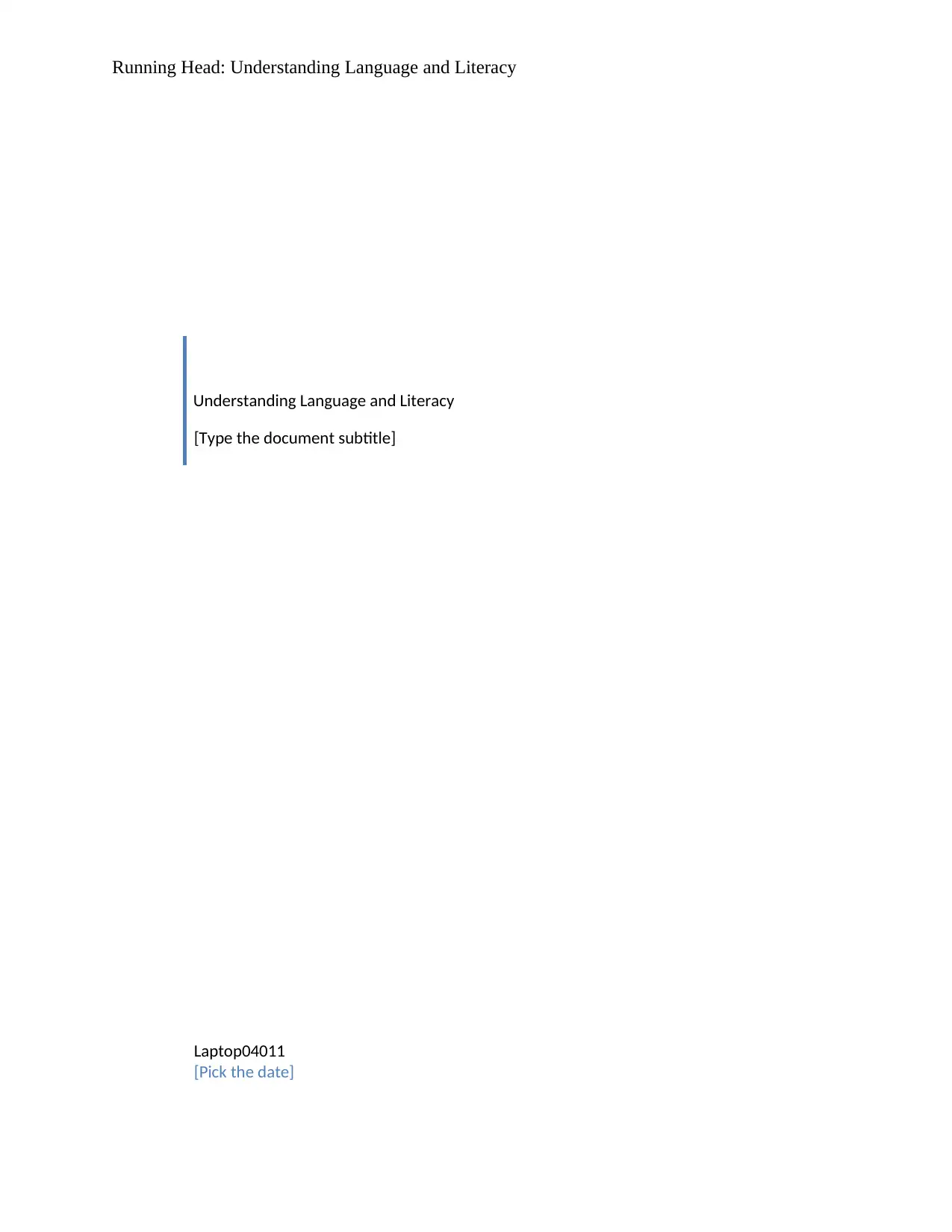
Running Head: Understanding Language and Literacy
Understanding Language and Literacy
[Type the document subtitle]
Laptop04011
[Pick the date]
Understanding Language and Literacy
[Type the document subtitle]
Laptop04011
[Pick the date]
Secure Best Marks with AI Grader
Need help grading? Try our AI Grader for instant feedback on your assignments.
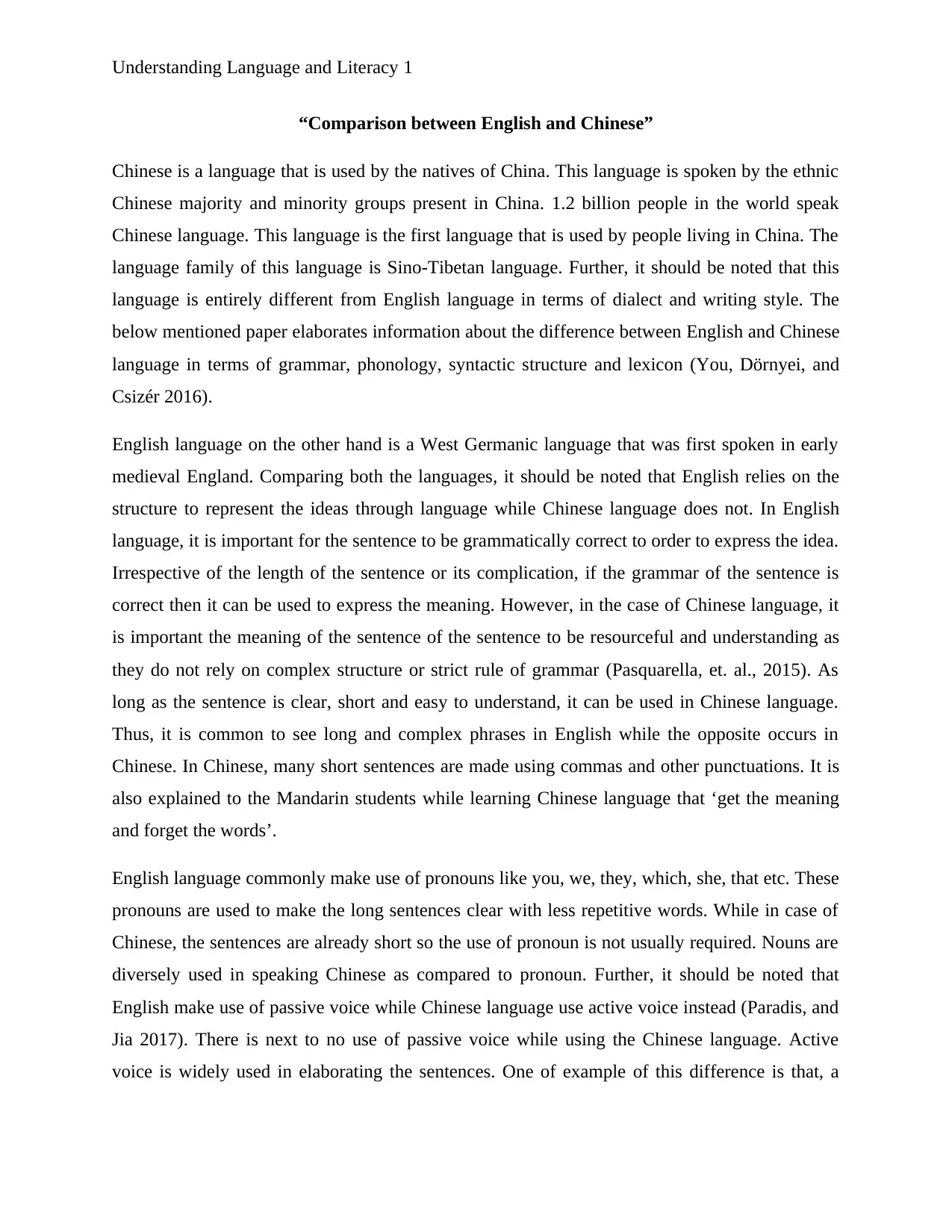
Understanding Language and Literacy 1
“Comparison between English and Chinese”
Chinese is a language that is used by the natives of China. This language is spoken by the ethnic
Chinese majority and minority groups present in China. 1.2 billion people in the world speak
Chinese language. This language is the first language that is used by people living in China. The
language family of this language is Sino-Tibetan language. Further, it should be noted that this
language is entirely different from English language in terms of dialect and writing style. The
below mentioned paper elaborates information about the difference between English and Chinese
language in terms of grammar, phonology, syntactic structure and lexicon (You, Dörnyei, and
Csizér 2016).
English language on the other hand is a West Germanic language that was first spoken in early
medieval England. Comparing both the languages, it should be noted that English relies on the
structure to represent the ideas through language while Chinese language does not. In English
language, it is important for the sentence to be grammatically correct to order to express the idea.
Irrespective of the length of the sentence or its complication, if the grammar of the sentence is
correct then it can be used to express the meaning. However, in the case of Chinese language, it
is important the meaning of the sentence of the sentence to be resourceful and understanding as
they do not rely on complex structure or strict rule of grammar (Pasquarella, et. al., 2015). As
long as the sentence is clear, short and easy to understand, it can be used in Chinese language.
Thus, it is common to see long and complex phrases in English while the opposite occurs in
Chinese. In Chinese, many short sentences are made using commas and other punctuations. It is
also explained to the Mandarin students while learning Chinese language that ‘get the meaning
and forget the words’.
English language commonly make use of pronouns like you, we, they, which, she, that etc. These
pronouns are used to make the long sentences clear with less repetitive words. While in case of
Chinese, the sentences are already short so the use of pronoun is not usually required. Nouns are
diversely used in speaking Chinese as compared to pronoun. Further, it should be noted that
English make use of passive voice while Chinese language use active voice instead (Paradis, and
Jia 2017). There is next to no use of passive voice while using the Chinese language. Active
voice is widely used in elaborating the sentences. One of example of this difference is that, a
“Comparison between English and Chinese”
Chinese is a language that is used by the natives of China. This language is spoken by the ethnic
Chinese majority and minority groups present in China. 1.2 billion people in the world speak
Chinese language. This language is the first language that is used by people living in China. The
language family of this language is Sino-Tibetan language. Further, it should be noted that this
language is entirely different from English language in terms of dialect and writing style. The
below mentioned paper elaborates information about the difference between English and Chinese
language in terms of grammar, phonology, syntactic structure and lexicon (You, Dörnyei, and
Csizér 2016).
English language on the other hand is a West Germanic language that was first spoken in early
medieval England. Comparing both the languages, it should be noted that English relies on the
structure to represent the ideas through language while Chinese language does not. In English
language, it is important for the sentence to be grammatically correct to order to express the idea.
Irrespective of the length of the sentence or its complication, if the grammar of the sentence is
correct then it can be used to express the meaning. However, in the case of Chinese language, it
is important the meaning of the sentence of the sentence to be resourceful and understanding as
they do not rely on complex structure or strict rule of grammar (Pasquarella, et. al., 2015). As
long as the sentence is clear, short and easy to understand, it can be used in Chinese language.
Thus, it is common to see long and complex phrases in English while the opposite occurs in
Chinese. In Chinese, many short sentences are made using commas and other punctuations. It is
also explained to the Mandarin students while learning Chinese language that ‘get the meaning
and forget the words’.
English language commonly make use of pronouns like you, we, they, which, she, that etc. These
pronouns are used to make the long sentences clear with less repetitive words. While in case of
Chinese, the sentences are already short so the use of pronoun is not usually required. Nouns are
diversely used in speaking Chinese as compared to pronoun. Further, it should be noted that
English make use of passive voice while Chinese language use active voice instead (Paradis, and
Jia 2017). There is next to no use of passive voice while using the Chinese language. Active
voice is widely used in elaborating the sentences. One of example of this difference is that, a
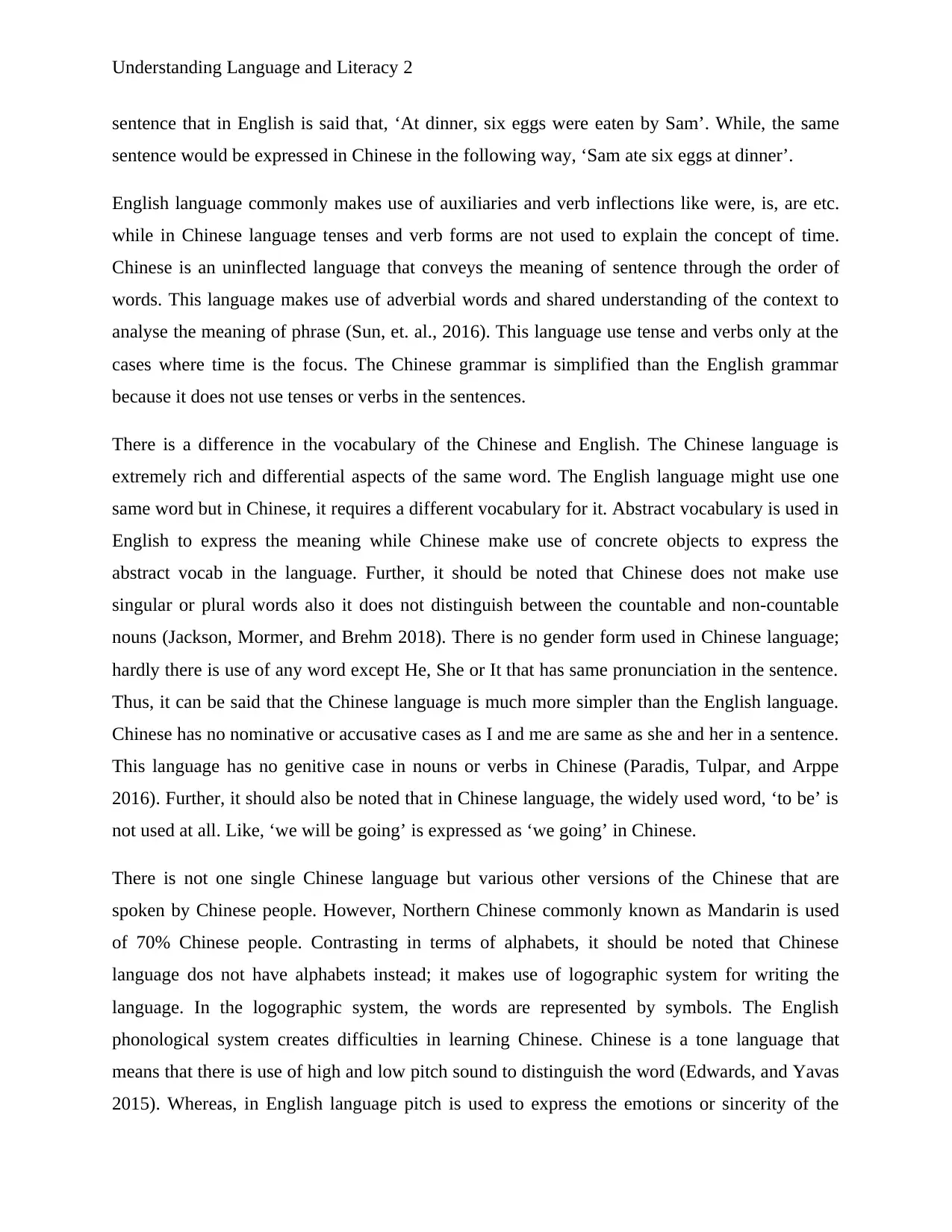
Understanding Language and Literacy 2
sentence that in English is said that, ‘At dinner, six eggs were eaten by Sam’. While, the same
sentence would be expressed in Chinese in the following way, ‘Sam ate six eggs at dinner’.
English language commonly makes use of auxiliaries and verb inflections like were, is, are etc.
while in Chinese language tenses and verb forms are not used to explain the concept of time.
Chinese is an uninflected language that conveys the meaning of sentence through the order of
words. This language makes use of adverbial words and shared understanding of the context to
analyse the meaning of phrase (Sun, et. al., 2016). This language use tense and verbs only at the
cases where time is the focus. The Chinese grammar is simplified than the English grammar
because it does not use tenses or verbs in the sentences.
There is a difference in the vocabulary of the Chinese and English. The Chinese language is
extremely rich and differential aspects of the same word. The English language might use one
same word but in Chinese, it requires a different vocabulary for it. Abstract vocabulary is used in
English to express the meaning while Chinese make use of concrete objects to express the
abstract vocab in the language. Further, it should be noted that Chinese does not make use
singular or plural words also it does not distinguish between the countable and non-countable
nouns (Jackson, Mormer, and Brehm 2018). There is no gender form used in Chinese language;
hardly there is use of any word except He, She or It that has same pronunciation in the sentence.
Thus, it can be said that the Chinese language is much more simpler than the English language.
Chinese has no nominative or accusative cases as I and me are same as she and her in a sentence.
This language has no genitive case in nouns or verbs in Chinese (Paradis, Tulpar, and Arppe
2016). Further, it should also be noted that in Chinese language, the widely used word, ‘to be’ is
not used at all. Like, ‘we will be going’ is expressed as ‘we going’ in Chinese.
There is not one single Chinese language but various other versions of the Chinese that are
spoken by Chinese people. However, Northern Chinese commonly known as Mandarin is used
of 70% Chinese people. Contrasting in terms of alphabets, it should be noted that Chinese
language dos not have alphabets instead; it makes use of logographic system for writing the
language. In the logographic system, the words are represented by symbols. The English
phonological system creates difficulties in learning Chinese. Chinese is a tone language that
means that there is use of high and low pitch sound to distinguish the word (Edwards, and Yavas
2015). Whereas, in English language pitch is used to express the emotions or sincerity of the
sentence that in English is said that, ‘At dinner, six eggs were eaten by Sam’. While, the same
sentence would be expressed in Chinese in the following way, ‘Sam ate six eggs at dinner’.
English language commonly makes use of auxiliaries and verb inflections like were, is, are etc.
while in Chinese language tenses and verb forms are not used to explain the concept of time.
Chinese is an uninflected language that conveys the meaning of sentence through the order of
words. This language makes use of adverbial words and shared understanding of the context to
analyse the meaning of phrase (Sun, et. al., 2016). This language use tense and verbs only at the
cases where time is the focus. The Chinese grammar is simplified than the English grammar
because it does not use tenses or verbs in the sentences.
There is a difference in the vocabulary of the Chinese and English. The Chinese language is
extremely rich and differential aspects of the same word. The English language might use one
same word but in Chinese, it requires a different vocabulary for it. Abstract vocabulary is used in
English to express the meaning while Chinese make use of concrete objects to express the
abstract vocab in the language. Further, it should be noted that Chinese does not make use
singular or plural words also it does not distinguish between the countable and non-countable
nouns (Jackson, Mormer, and Brehm 2018). There is no gender form used in Chinese language;
hardly there is use of any word except He, She or It that has same pronunciation in the sentence.
Thus, it can be said that the Chinese language is much more simpler than the English language.
Chinese has no nominative or accusative cases as I and me are same as she and her in a sentence.
This language has no genitive case in nouns or verbs in Chinese (Paradis, Tulpar, and Arppe
2016). Further, it should also be noted that in Chinese language, the widely used word, ‘to be’ is
not used at all. Like, ‘we will be going’ is expressed as ‘we going’ in Chinese.
There is not one single Chinese language but various other versions of the Chinese that are
spoken by Chinese people. However, Northern Chinese commonly known as Mandarin is used
of 70% Chinese people. Contrasting in terms of alphabets, it should be noted that Chinese
language dos not have alphabets instead; it makes use of logographic system for writing the
language. In the logographic system, the words are represented by symbols. The English
phonological system creates difficulties in learning Chinese. Chinese is a tone language that
means that there is use of high and low pitch sound to distinguish the word (Edwards, and Yavas
2015). Whereas, in English language pitch is used to express the emotions or sincerity of the
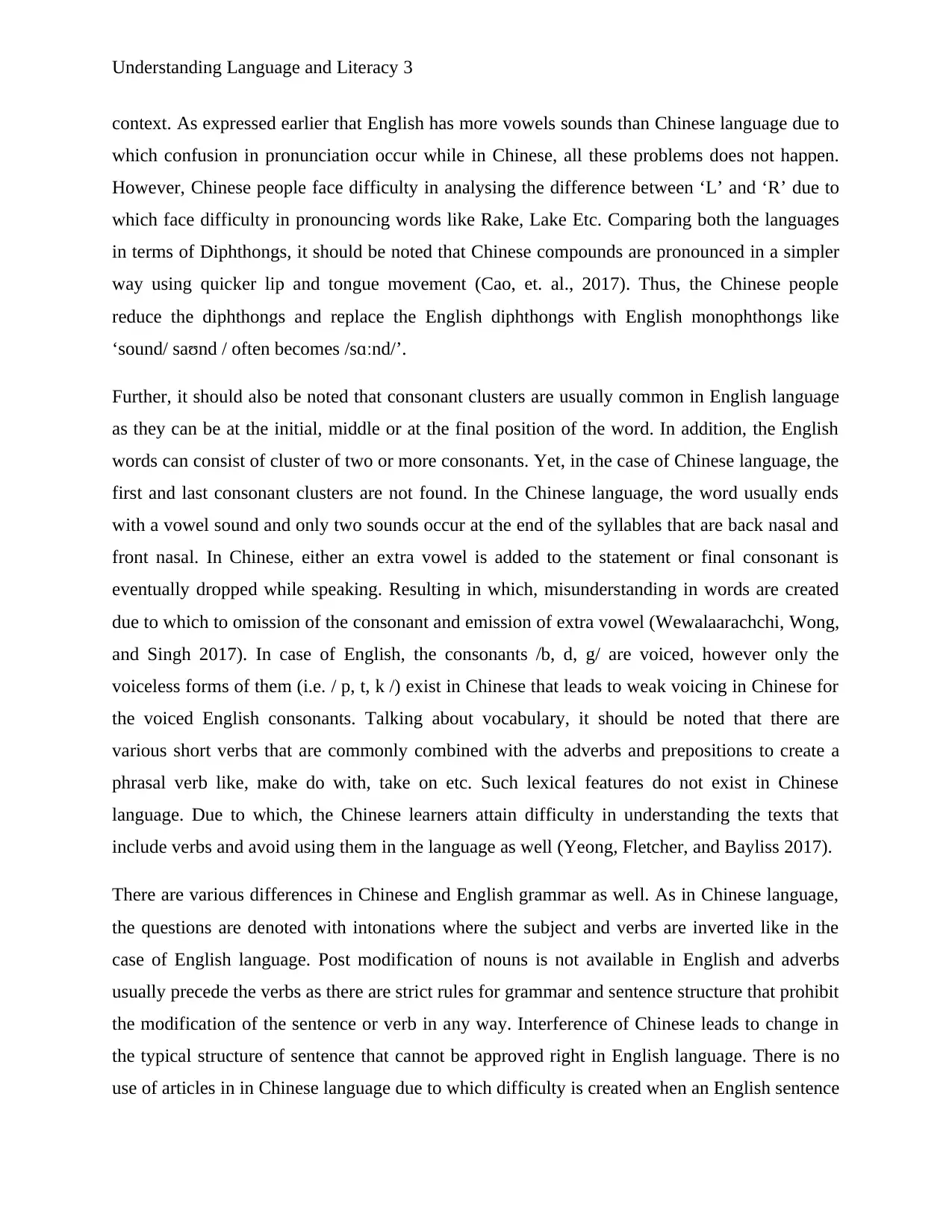
Understanding Language and Literacy 3
context. As expressed earlier that English has more vowels sounds than Chinese language due to
which confusion in pronunciation occur while in Chinese, all these problems does not happen.
However, Chinese people face difficulty in analysing the difference between ‘L’ and ‘R’ due to
which face difficulty in pronouncing words like Rake, Lake Etc. Comparing both the languages
in terms of Diphthongs, it should be noted that Chinese compounds are pronounced in a simpler
way using quicker lip and tongue movement (Cao, et. al., 2017). Thus, the Chinese people
reduce the diphthongs and replace the English diphthongs with English monophthongs like
‘sound/ saʊnd / often becomes /sɑːnd/’.
Further, it should also be noted that consonant clusters are usually common in English language
as they can be at the initial, middle or at the final position of the word. In addition, the English
words can consist of cluster of two or more consonants. Yet, in the case of Chinese language, the
first and last consonant clusters are not found. In the Chinese language, the word usually ends
with a vowel sound and only two sounds occur at the end of the syllables that are back nasal and
front nasal. In Chinese, either an extra vowel is added to the statement or final consonant is
eventually dropped while speaking. Resulting in which, misunderstanding in words are created
due to which to omission of the consonant and emission of extra vowel (Wewalaarachchi, Wong,
and Singh 2017). In case of English, the consonants /b, d, g/ are voiced, however only the
voiceless forms of them (i.e. / p, t, k /) exist in Chinese that leads to weak voicing in Chinese for
the voiced English consonants. Talking about vocabulary, it should be noted that there are
various short verbs that are commonly combined with the adverbs and prepositions to create a
phrasal verb like, make do with, take on etc. Such lexical features do not exist in Chinese
language. Due to which, the Chinese learners attain difficulty in understanding the texts that
include verbs and avoid using them in the language as well (Yeong, Fletcher, and Bayliss 2017).
There are various differences in Chinese and English grammar as well. As in Chinese language,
the questions are denoted with intonations where the subject and verbs are inverted like in the
case of English language. Post modification of nouns is not available in English and adverbs
usually precede the verbs as there are strict rules for grammar and sentence structure that prohibit
the modification of the sentence or verb in any way. Interference of Chinese leads to change in
the typical structure of sentence that cannot be approved right in English language. There is no
use of articles in in Chinese language due to which difficulty is created when an English sentence
context. As expressed earlier that English has more vowels sounds than Chinese language due to
which confusion in pronunciation occur while in Chinese, all these problems does not happen.
However, Chinese people face difficulty in analysing the difference between ‘L’ and ‘R’ due to
which face difficulty in pronouncing words like Rake, Lake Etc. Comparing both the languages
in terms of Diphthongs, it should be noted that Chinese compounds are pronounced in a simpler
way using quicker lip and tongue movement (Cao, et. al., 2017). Thus, the Chinese people
reduce the diphthongs and replace the English diphthongs with English monophthongs like
‘sound/ saʊnd / often becomes /sɑːnd/’.
Further, it should also be noted that consonant clusters are usually common in English language
as they can be at the initial, middle or at the final position of the word. In addition, the English
words can consist of cluster of two or more consonants. Yet, in the case of Chinese language, the
first and last consonant clusters are not found. In the Chinese language, the word usually ends
with a vowel sound and only two sounds occur at the end of the syllables that are back nasal and
front nasal. In Chinese, either an extra vowel is added to the statement or final consonant is
eventually dropped while speaking. Resulting in which, misunderstanding in words are created
due to which to omission of the consonant and emission of extra vowel (Wewalaarachchi, Wong,
and Singh 2017). In case of English, the consonants /b, d, g/ are voiced, however only the
voiceless forms of them (i.e. / p, t, k /) exist in Chinese that leads to weak voicing in Chinese for
the voiced English consonants. Talking about vocabulary, it should be noted that there are
various short verbs that are commonly combined with the adverbs and prepositions to create a
phrasal verb like, make do with, take on etc. Such lexical features do not exist in Chinese
language. Due to which, the Chinese learners attain difficulty in understanding the texts that
include verbs and avoid using them in the language as well (Yeong, Fletcher, and Bayliss 2017).
There are various differences in Chinese and English grammar as well. As in Chinese language,
the questions are denoted with intonations where the subject and verbs are inverted like in the
case of English language. Post modification of nouns is not available in English and adverbs
usually precede the verbs as there are strict rules for grammar and sentence structure that prohibit
the modification of the sentence or verb in any way. Interference of Chinese leads to change in
the typical structure of sentence that cannot be approved right in English language. There is no
use of articles in in Chinese language due to which difficulty is created when an English sentence
Secure Best Marks with AI Grader
Need help grading? Try our AI Grader for instant feedback on your assignments.

Understanding Language and Literacy 4
is converted into Chinese (Wong, et. al., 2017). Lastly, it should also be noted that Chinglish is
also a language that is commonly used in China. The basic feature of this language is that it
makes use of low level of level of English proficiency that reveals the interference of
phonological and grammatical aspects.
Thus, it should be noted that Chinese and English are two different languages that create a
negative impact if used together. The phonology, vocabulary etc. of both the languages are
different and creates deviations if used together. Like in the given case of Chinglish, rules of one
language are degraded just to maintain the rules of other language. Therefore, such differences
and deviations differentiate both the languages in the worldwide environment.
is converted into Chinese (Wong, et. al., 2017). Lastly, it should also be noted that Chinglish is
also a language that is commonly used in China. The basic feature of this language is that it
makes use of low level of level of English proficiency that reveals the interference of
phonological and grammatical aspects.
Thus, it should be noted that Chinese and English are two different languages that create a
negative impact if used together. The phonology, vocabulary etc. of both the languages are
different and creates deviations if used together. Like in the given case of Chinglish, rules of one
language are degraded just to maintain the rules of other language. Therefore, such differences
and deviations differentiate both the languages in the worldwide environment.
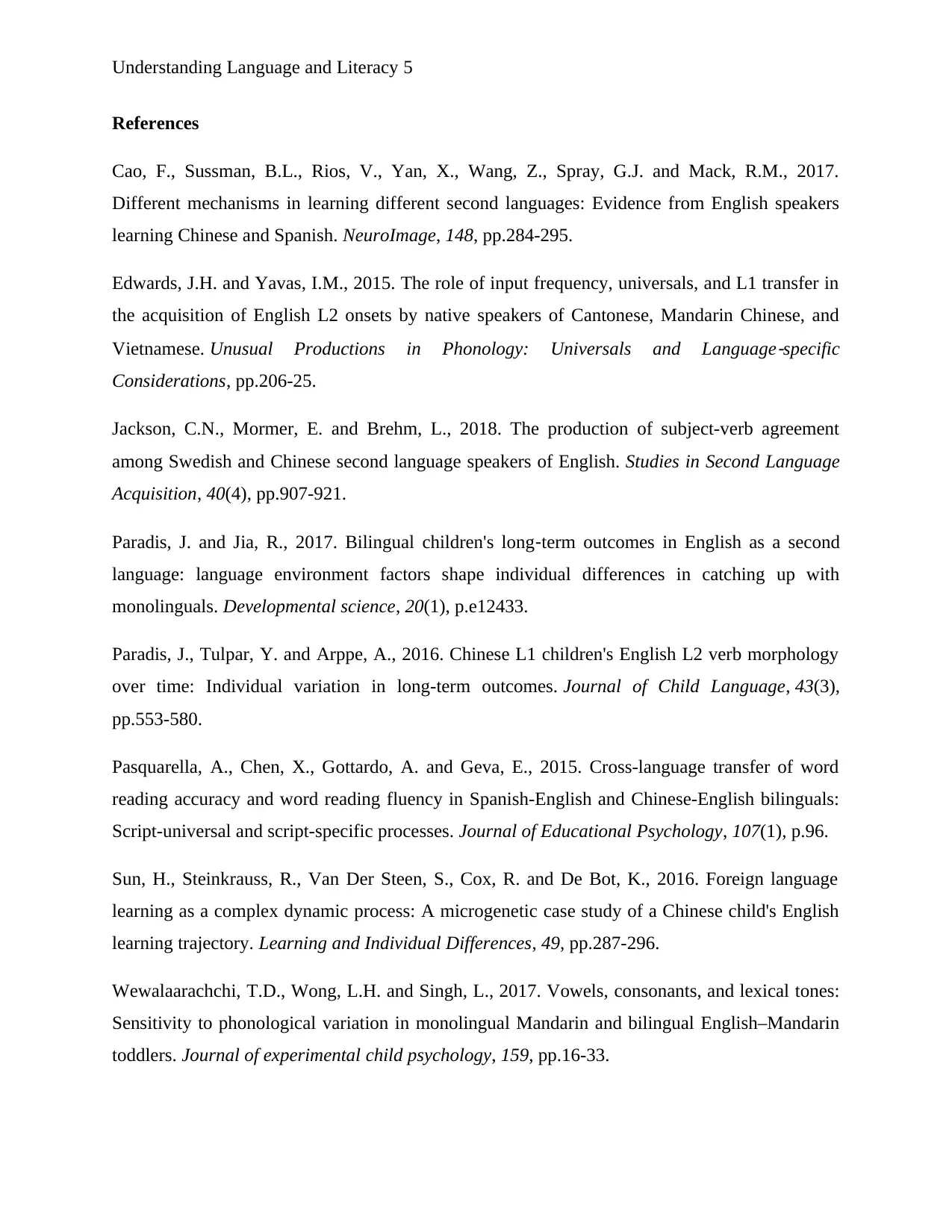
Understanding Language and Literacy 5
References
Cao, F., Sussman, B.L., Rios, V., Yan, X., Wang, Z., Spray, G.J. and Mack, R.M., 2017.
Different mechanisms in learning different second languages: Evidence from English speakers
learning Chinese and Spanish. NeuroImage, 148, pp.284-295.
Edwards, J.H. and Yavas, I.M., 2015. The role of input frequency, universals, and L1 transfer in
the acquisition of English L2 onsets by native speakers of Cantonese, Mandarin Chinese, and
Vietnamese. Unusual Productions in Phonology: Universals and Language
‐specific
Considerations, pp.206-25.
Jackson, C.N., Mormer, E. and Brehm, L., 2018. The production of subject-verb agreement
among Swedish and Chinese second language speakers of English. Studies in Second Language
Acquisition, 40(4), pp.907-921.
Paradis, J. and Jia, R., 2017. Bilingual children's long‐term outcomes in English as a second
language: language environment factors shape individual differences in catching up with
monolinguals. Developmental science, 20(1), p.e12433.
Paradis, J., Tulpar, Y. and Arppe, A., 2016. Chinese L1 children's English L2 verb morphology
over time: Individual variation in long-term outcomes. Journal of Child Language, 43(3),
pp.553-580.
Pasquarella, A., Chen, X., Gottardo, A. and Geva, E., 2015. Cross-language transfer of word
reading accuracy and word reading fluency in Spanish-English and Chinese-English bilinguals:
Script-universal and script-specific processes. Journal of Educational Psychology, 107(1), p.96.
Sun, H., Steinkrauss, R., Van Der Steen, S., Cox, R. and De Bot, K., 2016. Foreign language
learning as a complex dynamic process: A microgenetic case study of a Chinese child's English
learning trajectory. Learning and Individual Differences, 49, pp.287-296.
Wewalaarachchi, T.D., Wong, L.H. and Singh, L., 2017. Vowels, consonants, and lexical tones:
Sensitivity to phonological variation in monolingual Mandarin and bilingual English–Mandarin
toddlers. Journal of experimental child psychology, 159, pp.16-33.
References
Cao, F., Sussman, B.L., Rios, V., Yan, X., Wang, Z., Spray, G.J. and Mack, R.M., 2017.
Different mechanisms in learning different second languages: Evidence from English speakers
learning Chinese and Spanish. NeuroImage, 148, pp.284-295.
Edwards, J.H. and Yavas, I.M., 2015. The role of input frequency, universals, and L1 transfer in
the acquisition of English L2 onsets by native speakers of Cantonese, Mandarin Chinese, and
Vietnamese. Unusual Productions in Phonology: Universals and Language
‐specific
Considerations, pp.206-25.
Jackson, C.N., Mormer, E. and Brehm, L., 2018. The production of subject-verb agreement
among Swedish and Chinese second language speakers of English. Studies in Second Language
Acquisition, 40(4), pp.907-921.
Paradis, J. and Jia, R., 2017. Bilingual children's long‐term outcomes in English as a second
language: language environment factors shape individual differences in catching up with
monolinguals. Developmental science, 20(1), p.e12433.
Paradis, J., Tulpar, Y. and Arppe, A., 2016. Chinese L1 children's English L2 verb morphology
over time: Individual variation in long-term outcomes. Journal of Child Language, 43(3),
pp.553-580.
Pasquarella, A., Chen, X., Gottardo, A. and Geva, E., 2015. Cross-language transfer of word
reading accuracy and word reading fluency in Spanish-English and Chinese-English bilinguals:
Script-universal and script-specific processes. Journal of Educational Psychology, 107(1), p.96.
Sun, H., Steinkrauss, R., Van Der Steen, S., Cox, R. and De Bot, K., 2016. Foreign language
learning as a complex dynamic process: A microgenetic case study of a Chinese child's English
learning trajectory. Learning and Individual Differences, 49, pp.287-296.
Wewalaarachchi, T.D., Wong, L.H. and Singh, L., 2017. Vowels, consonants, and lexical tones:
Sensitivity to phonological variation in monolingual Mandarin and bilingual English–Mandarin
toddlers. Journal of experimental child psychology, 159, pp.16-33.
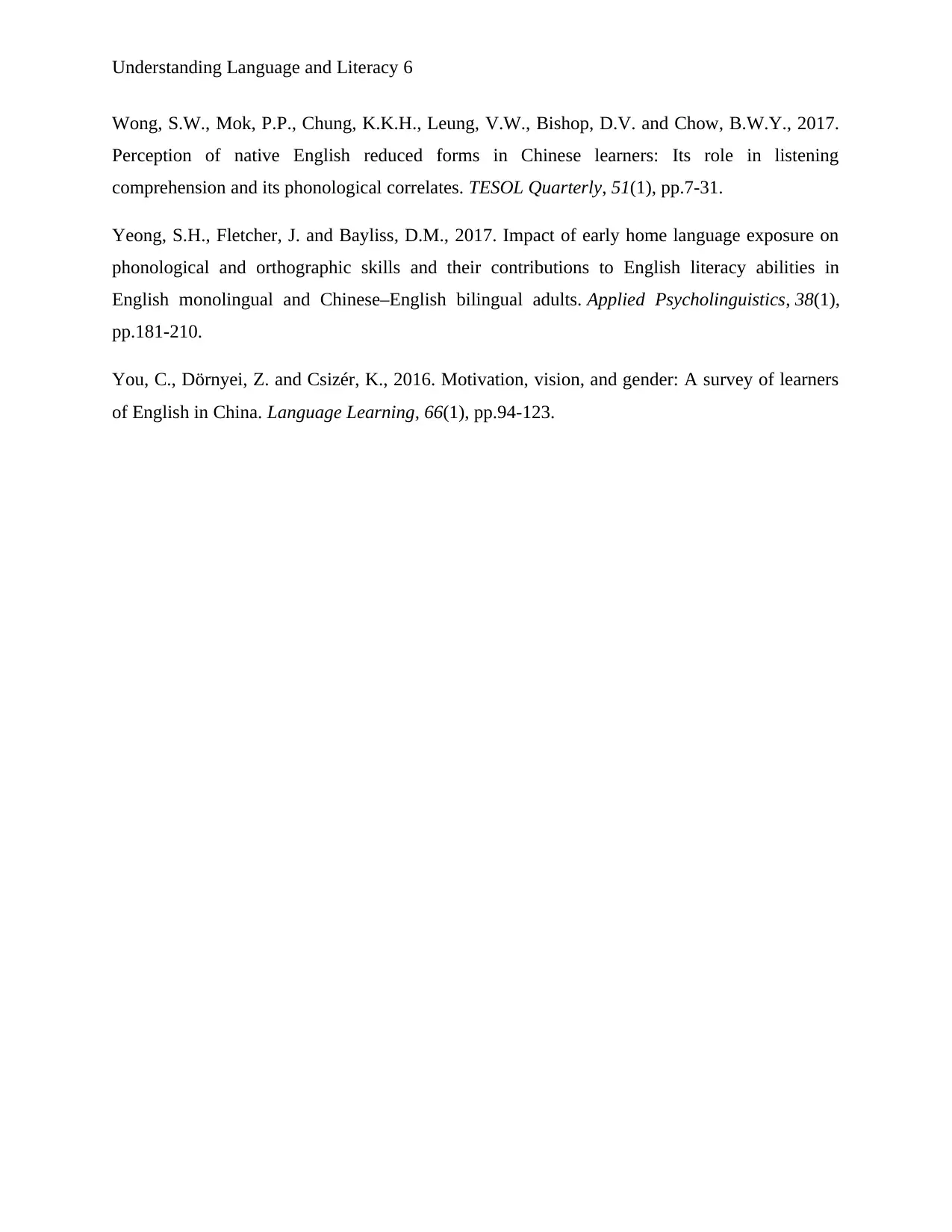
Understanding Language and Literacy 6
Wong, S.W., Mok, P.P., Chung, K.K.H., Leung, V.W., Bishop, D.V. and Chow, B.W.Y., 2017.
Perception of native English reduced forms in Chinese learners: Its role in listening
comprehension and its phonological correlates. TESOL Quarterly, 51(1), pp.7-31.
Yeong, S.H., Fletcher, J. and Bayliss, D.M., 2017. Impact of early home language exposure on
phonological and orthographic skills and their contributions to English literacy abilities in
English monolingual and Chinese–English bilingual adults. Applied Psycholinguistics, 38(1),
pp.181-210.
You, C., Dörnyei, Z. and Csizér, K., 2016. Motivation, vision, and gender: A survey of learners
of English in China. Language Learning, 66(1), pp.94-123.
Wong, S.W., Mok, P.P., Chung, K.K.H., Leung, V.W., Bishop, D.V. and Chow, B.W.Y., 2017.
Perception of native English reduced forms in Chinese learners: Its role in listening
comprehension and its phonological correlates. TESOL Quarterly, 51(1), pp.7-31.
Yeong, S.H., Fletcher, J. and Bayliss, D.M., 2017. Impact of early home language exposure on
phonological and orthographic skills and their contributions to English literacy abilities in
English monolingual and Chinese–English bilingual adults. Applied Psycholinguistics, 38(1),
pp.181-210.
You, C., Dörnyei, Z. and Csizér, K., 2016. Motivation, vision, and gender: A survey of learners
of English in China. Language Learning, 66(1), pp.94-123.
1 out of 7
Related Documents
Your All-in-One AI-Powered Toolkit for Academic Success.
+13062052269
info@desklib.com
Available 24*7 on WhatsApp / Email
![[object Object]](/_next/static/media/star-bottom.7253800d.svg)
Unlock your academic potential
© 2024 | Zucol Services PVT LTD | All rights reserved.
